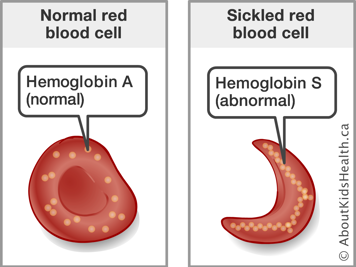Sickle cell disease is a group of blood disorders that stop blood flowing normally in the body.
Hemoglobin is the main ingredient in red blood cells. Its job is to help the blood carry oxygen from the lungs to other parts of the body. There are different types of hemoglobin, including hemoglobin A (normal hemoglobin) and hemoglobin C and S (abnormal types of hemoglobin).
Normal red blood cells have mostly hemoglobin A, which helps keep them soft and round so they flow easily through small blood vessels. People with sickle cell disease, however, have mostly hemoglobin S (also called sickle hemoglobin). Hemoglobin S can form hard fibers inside the red blood cells, causing them to reshape into sickle (or banana) shapes. When red blood cells are curved like this, they cannot move through blood vessels easily. Sometimes, they even get stuck and are unable to deliver oxygen to some body tissues.

How does someone get sickle cell disease?
Sickle cell disease is always inherited (passed down in families). It is not contagious. This means you cannot spread it like a cold, and you cannot catch it from someone else.
How common is sickle cell disease?
- Sickle cell disease is the most common inherited blood disorder in the United States and Canada.
- It can occur in all races but is most common in people of African, Caribbean or South American descent.






